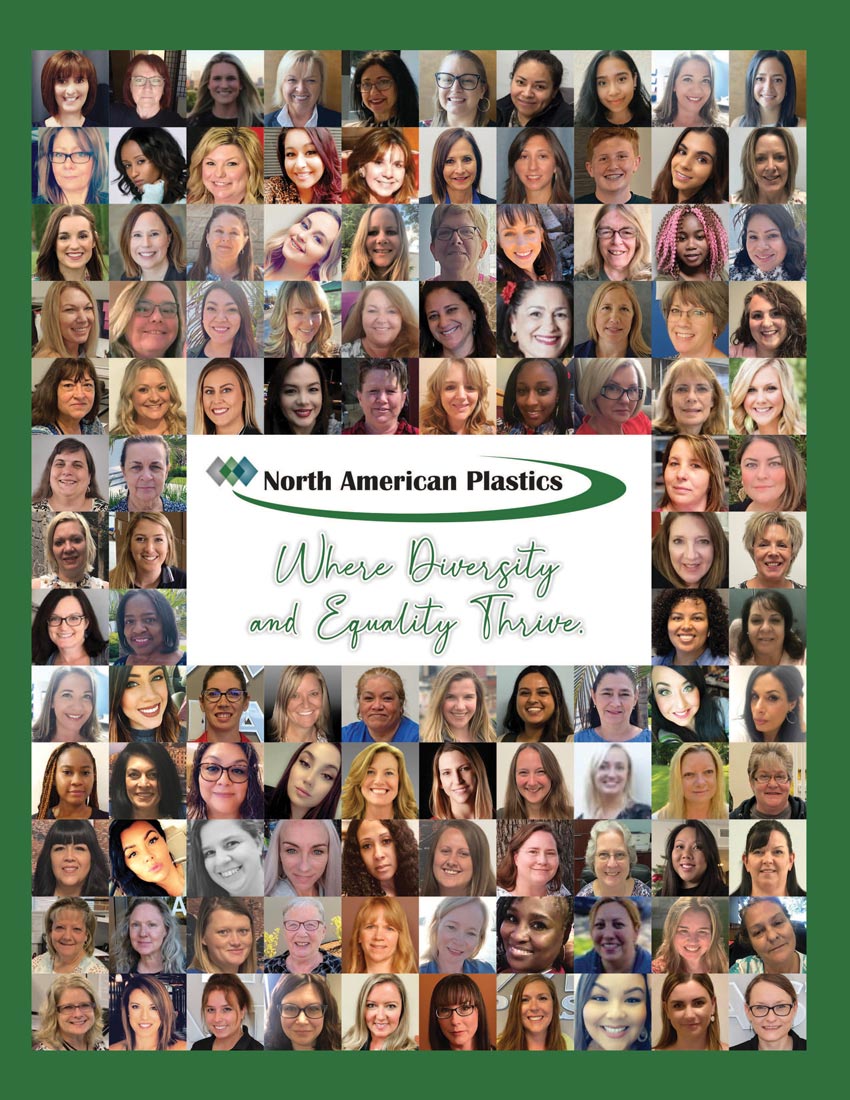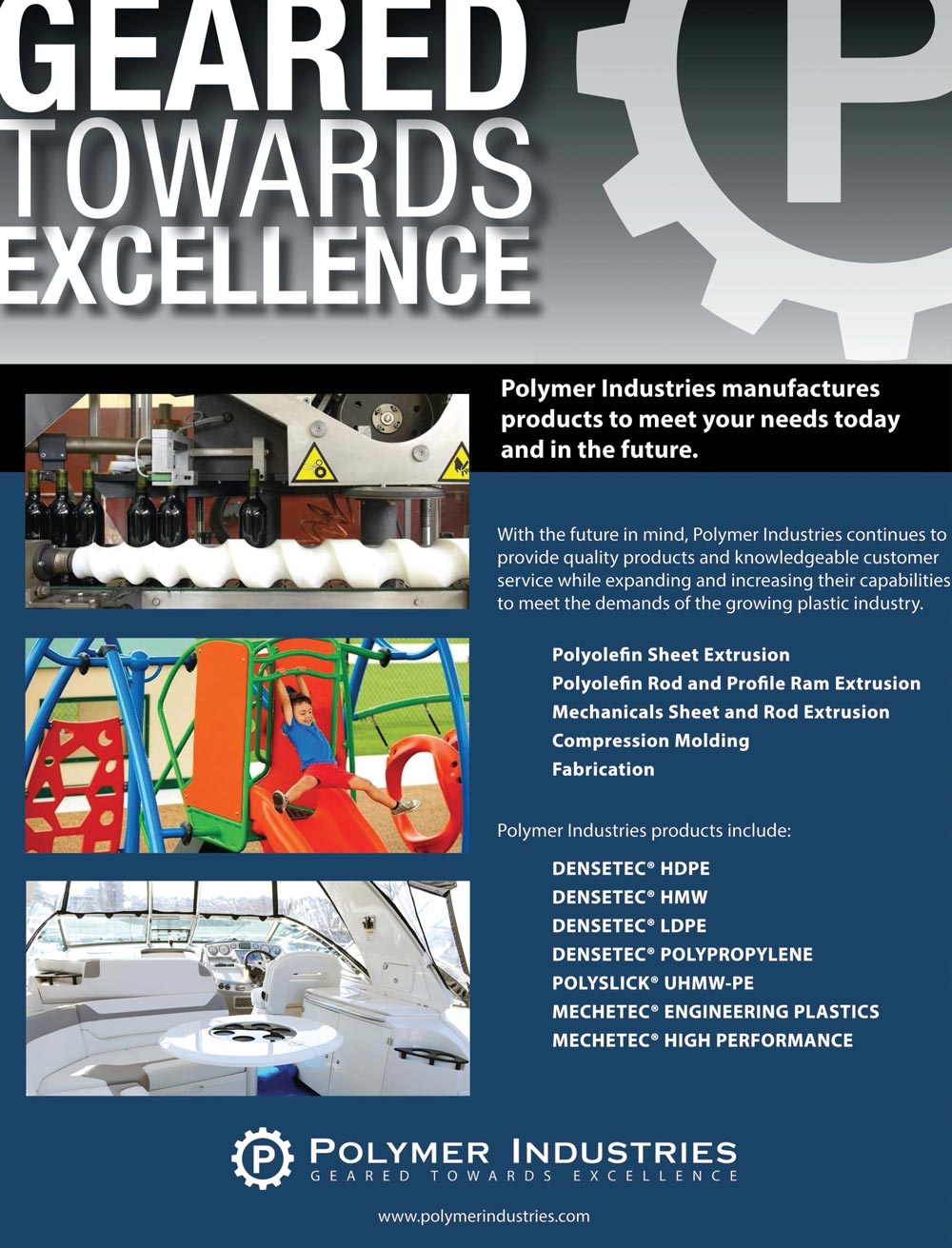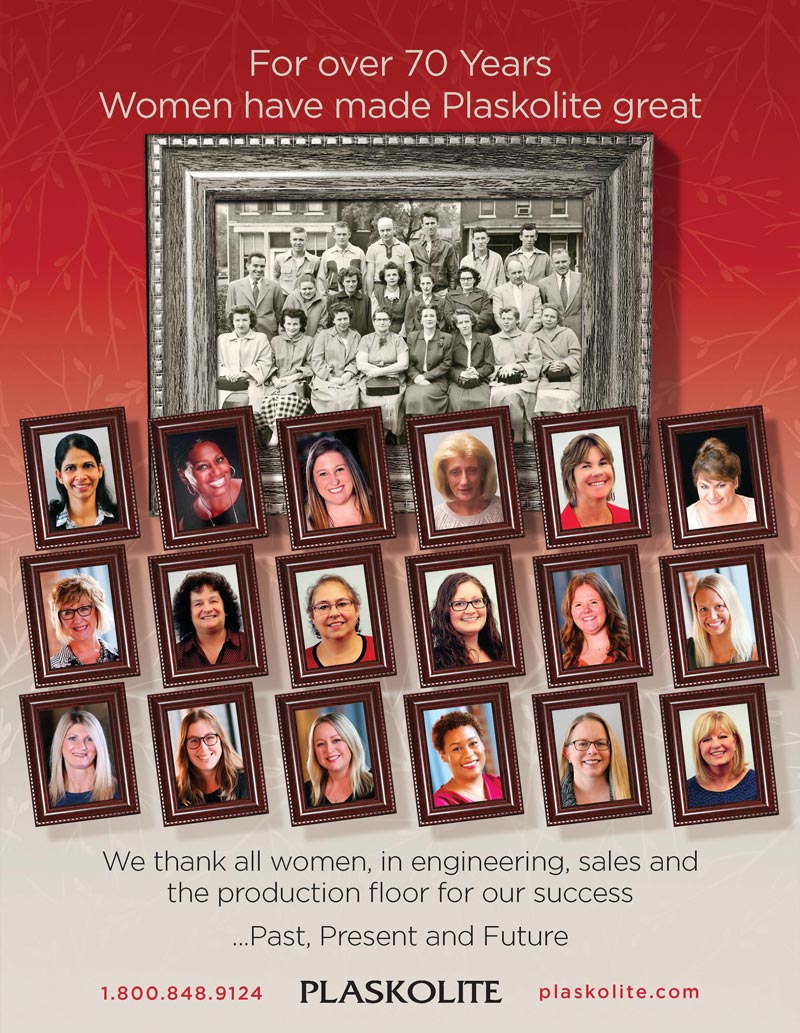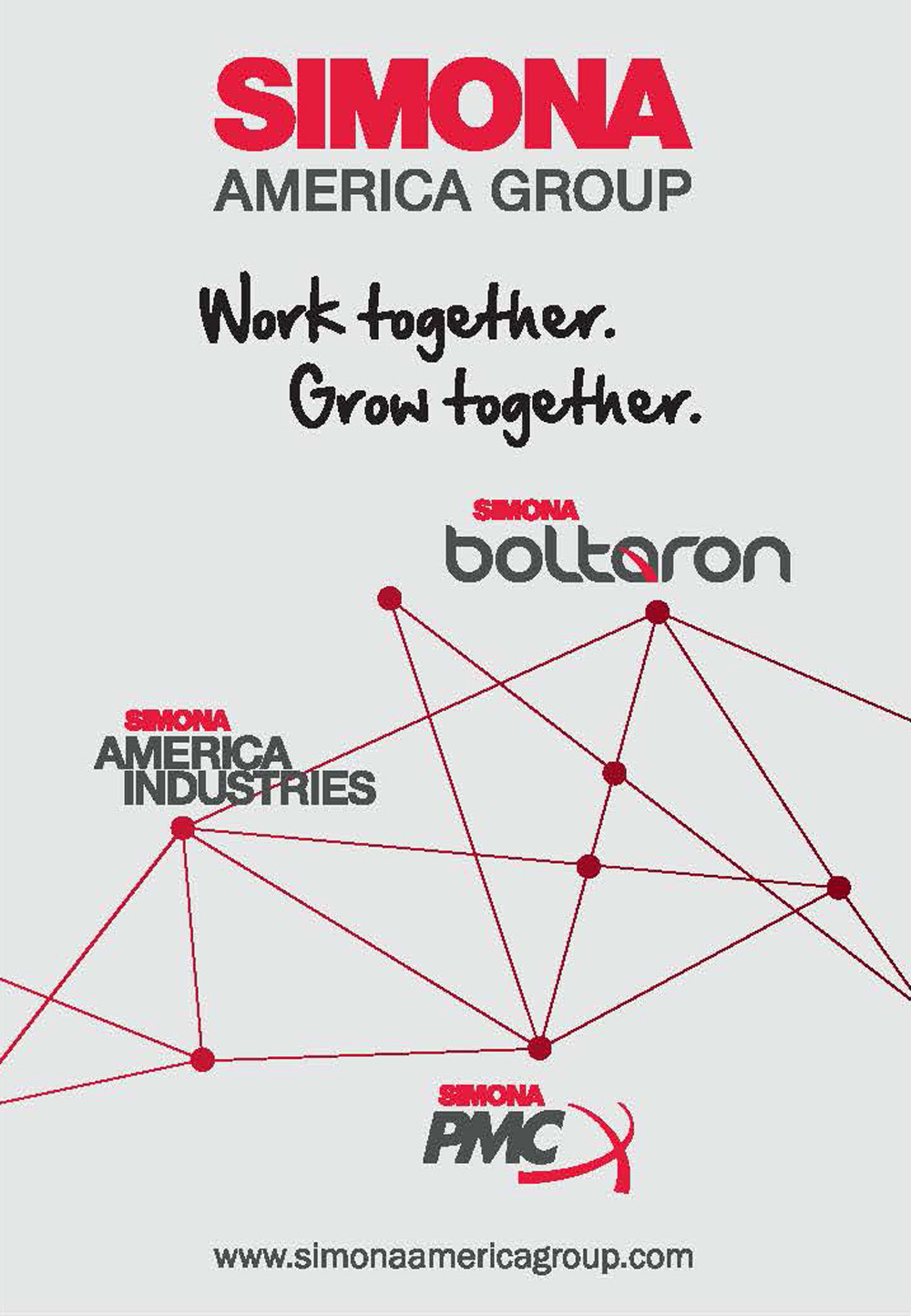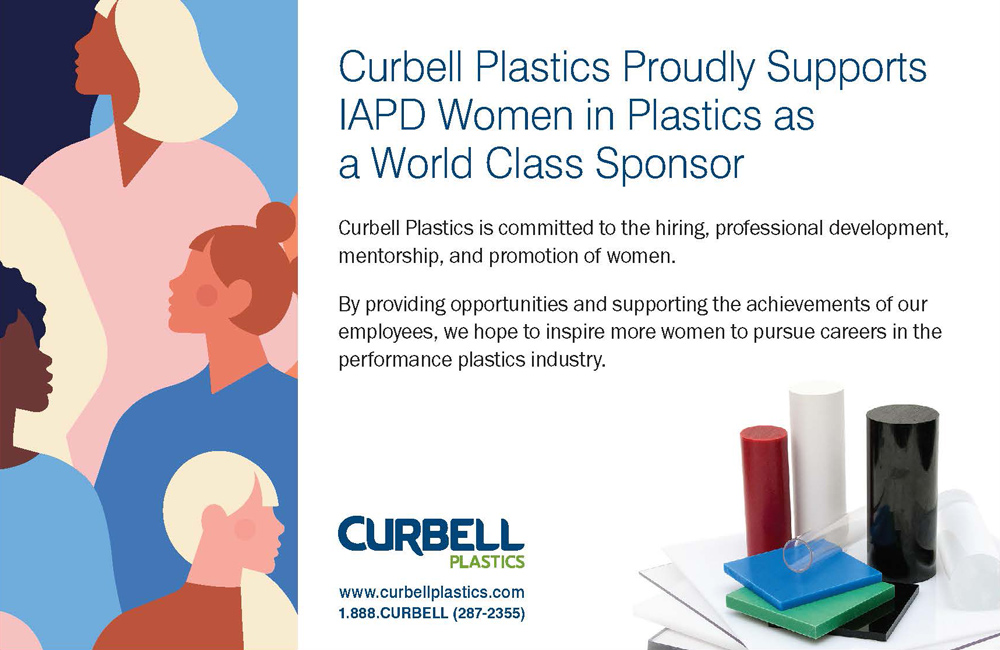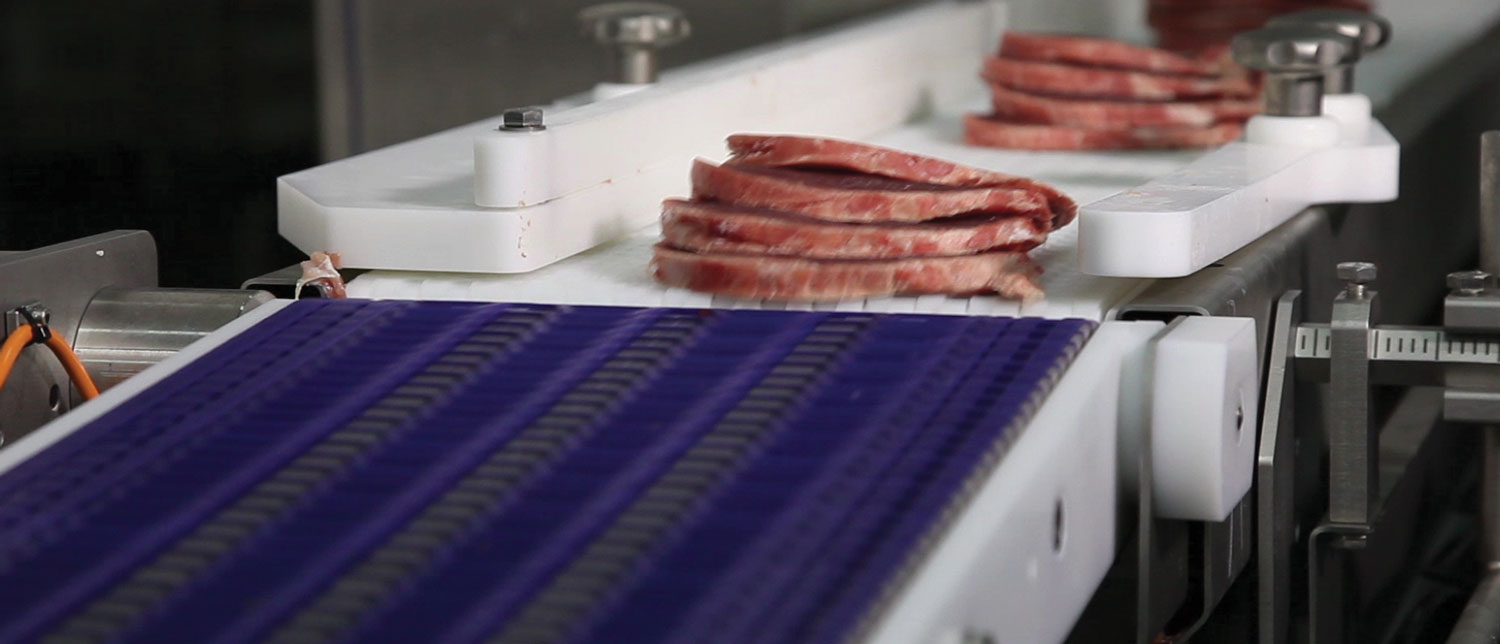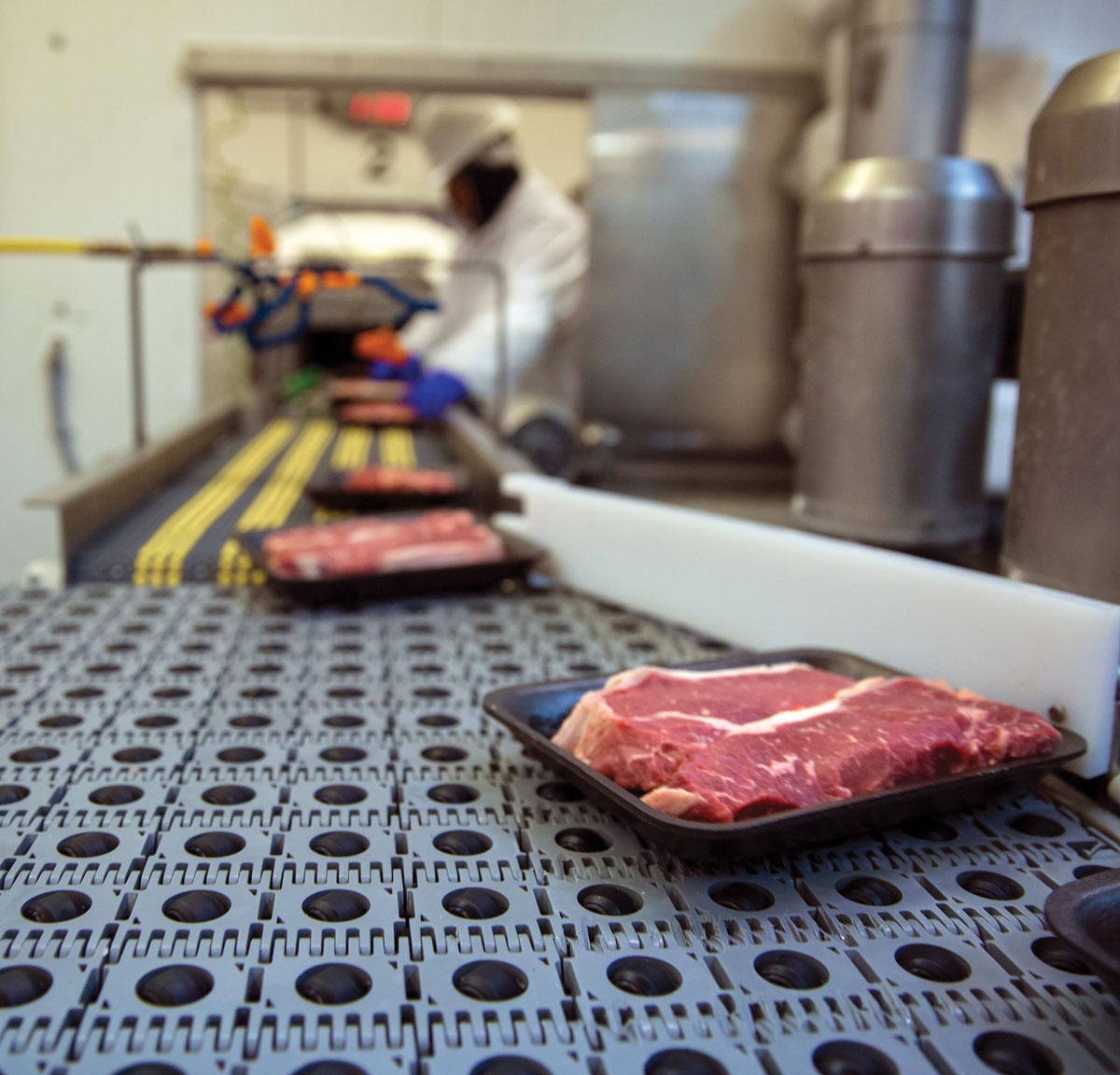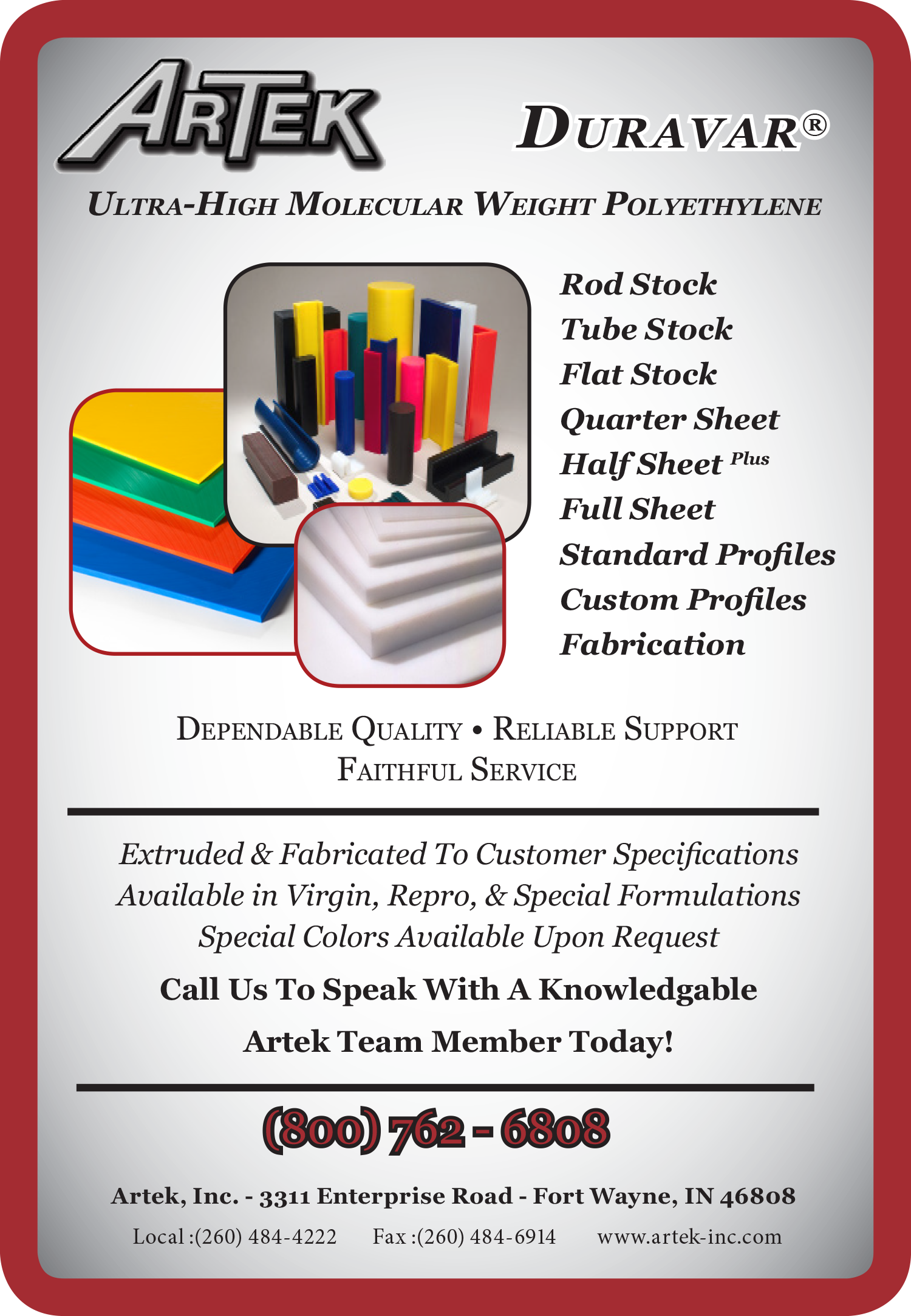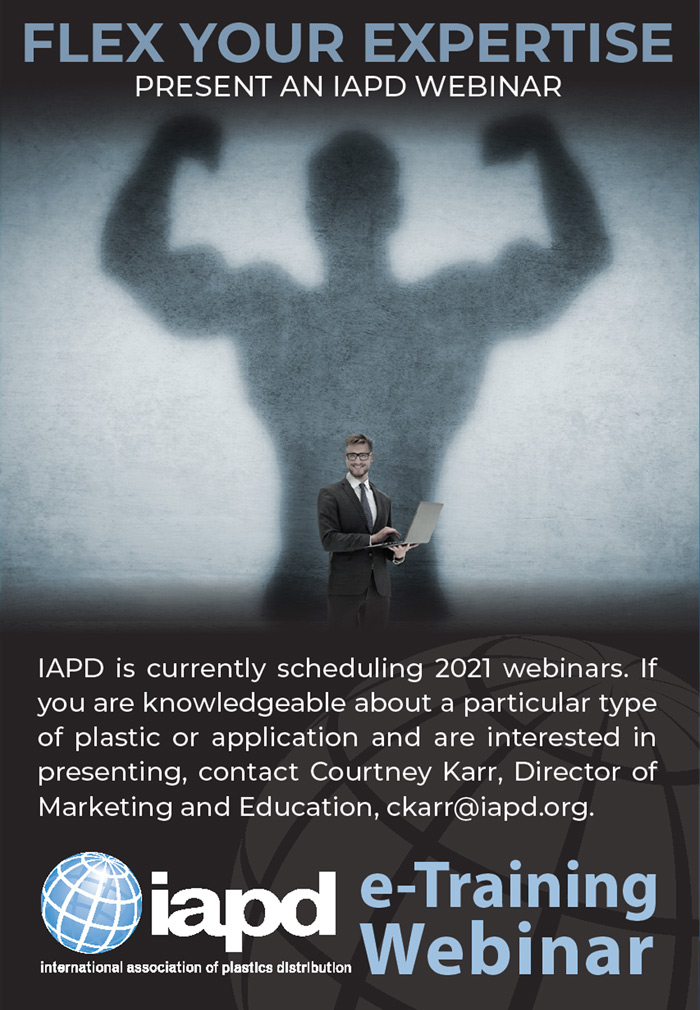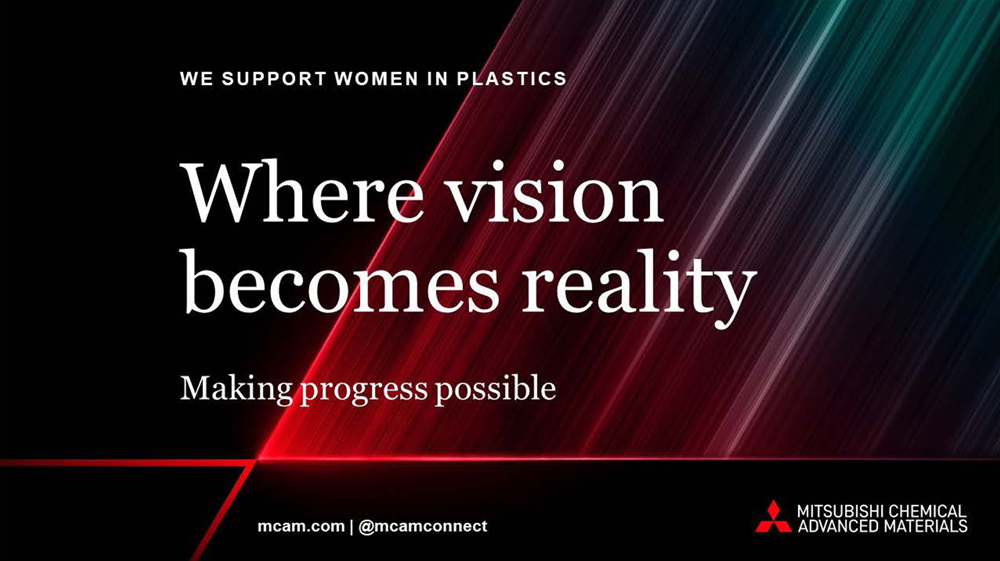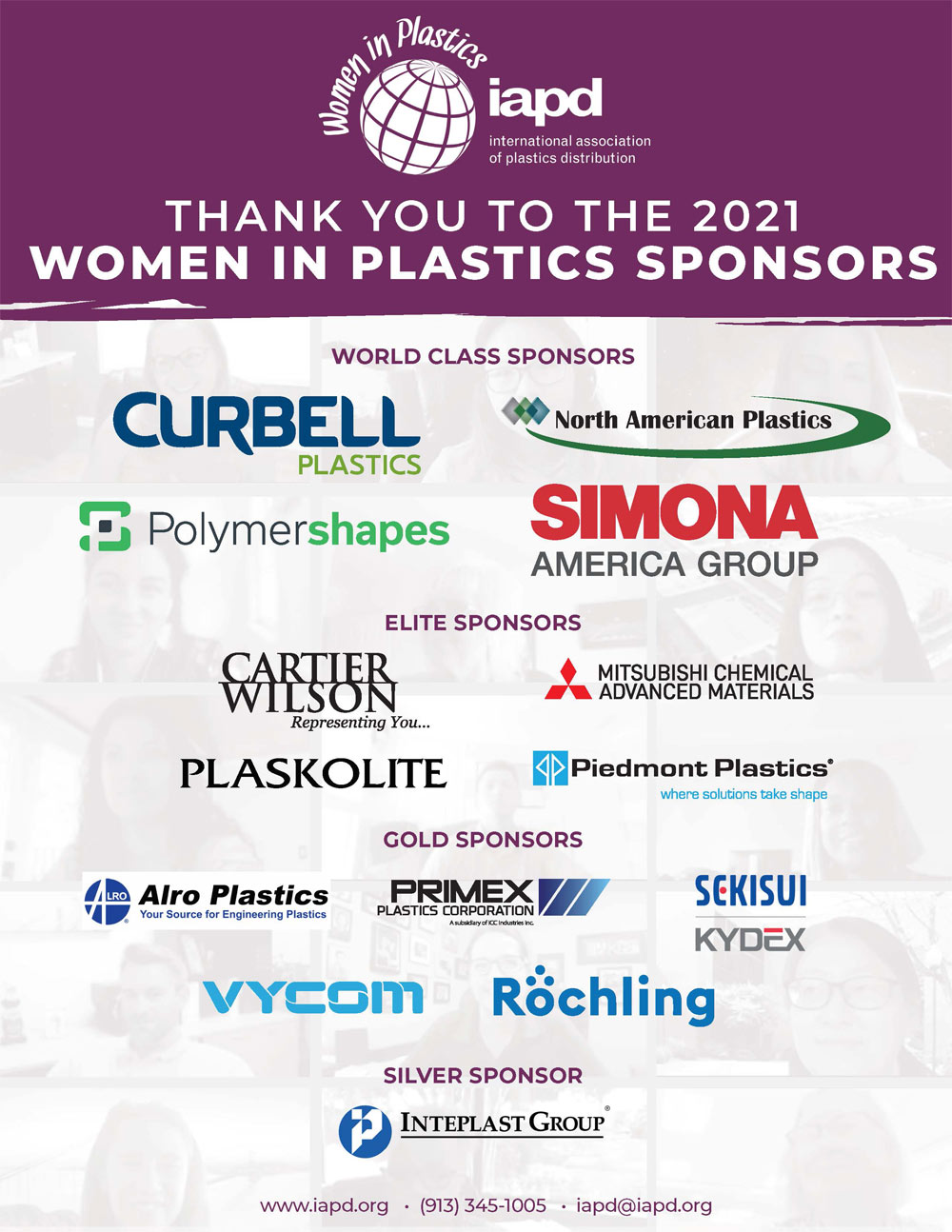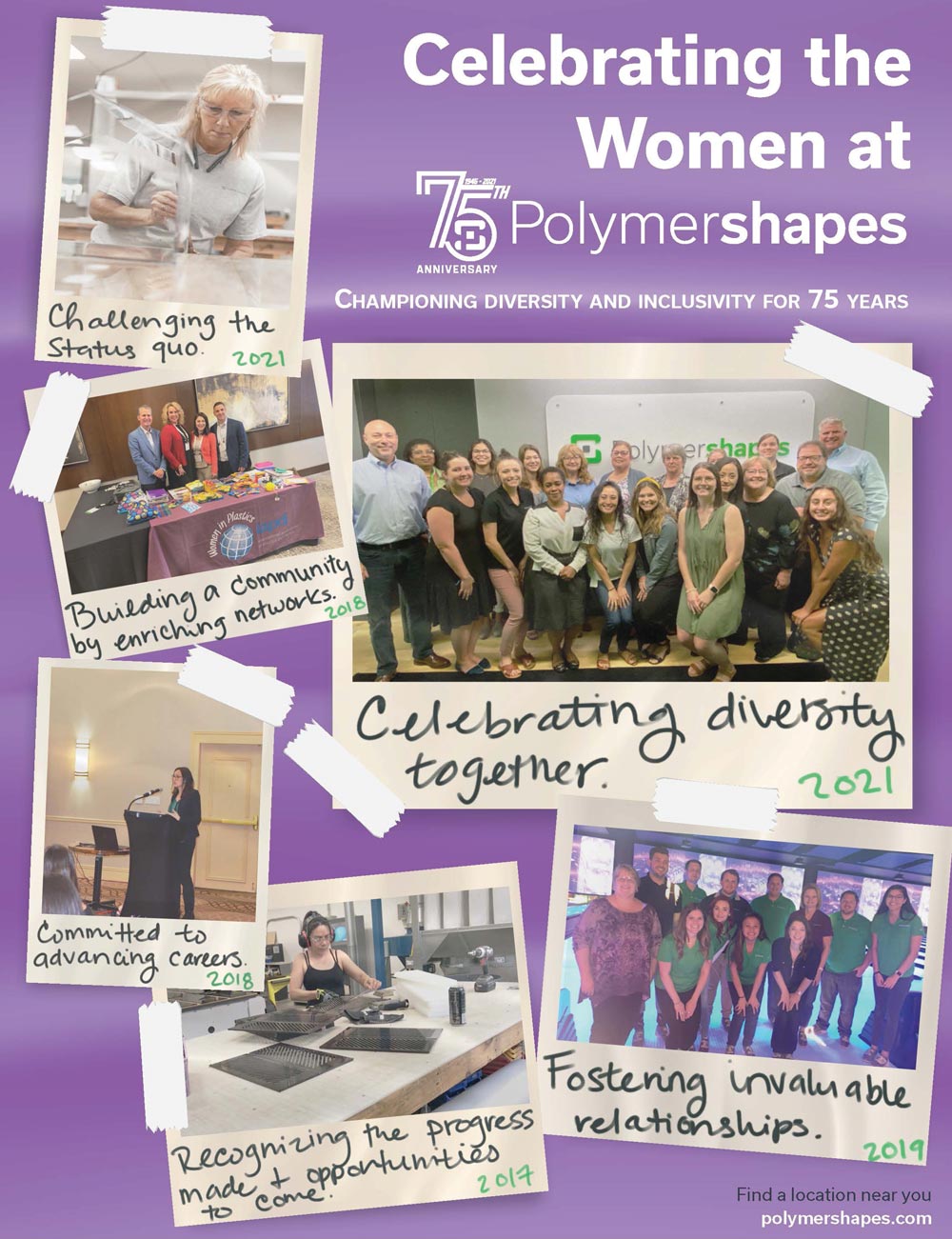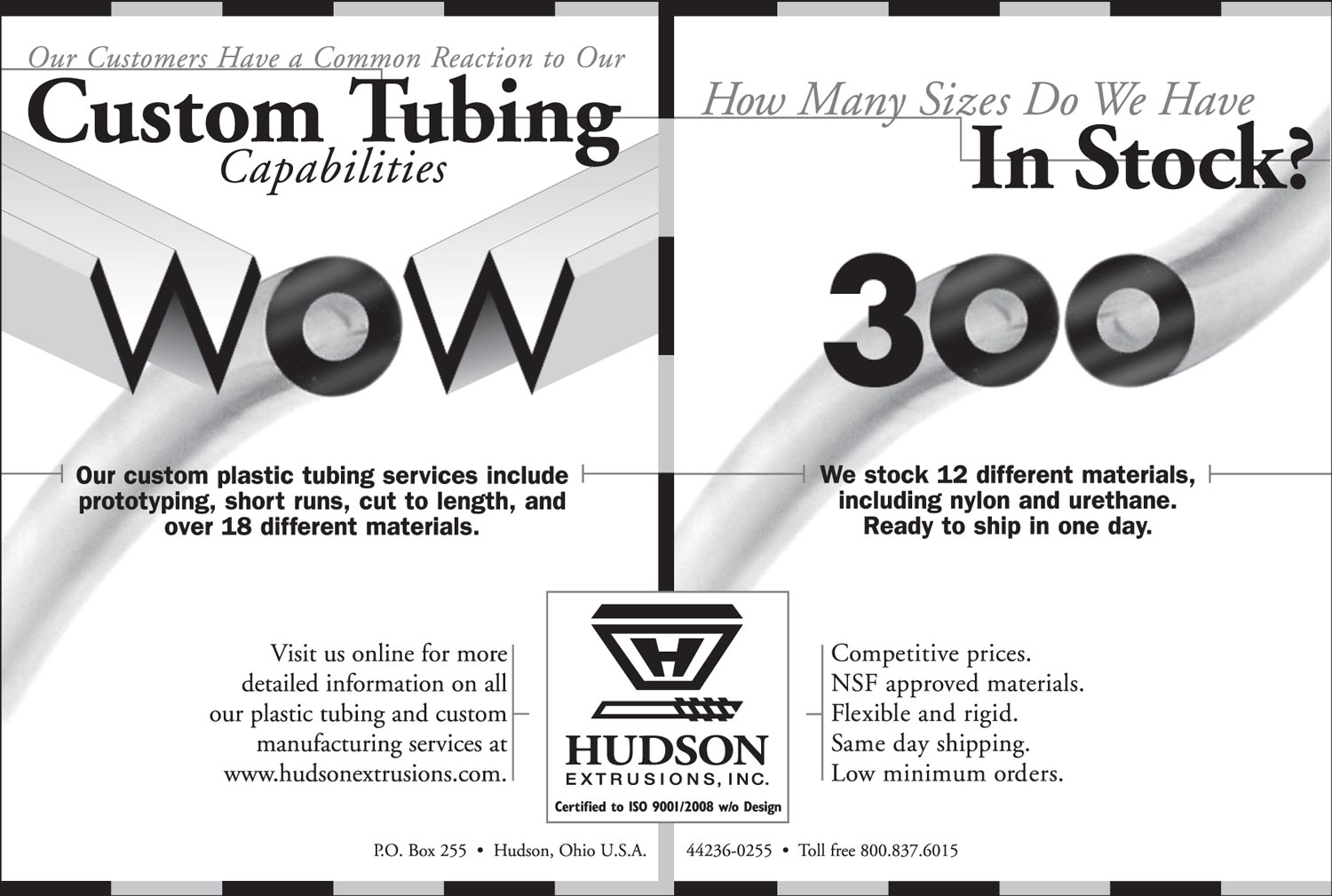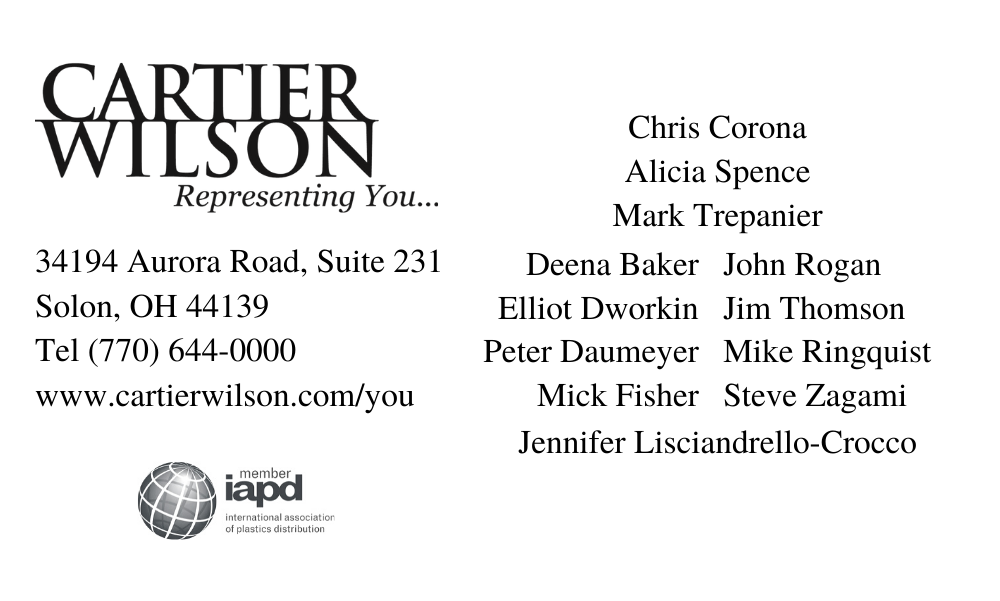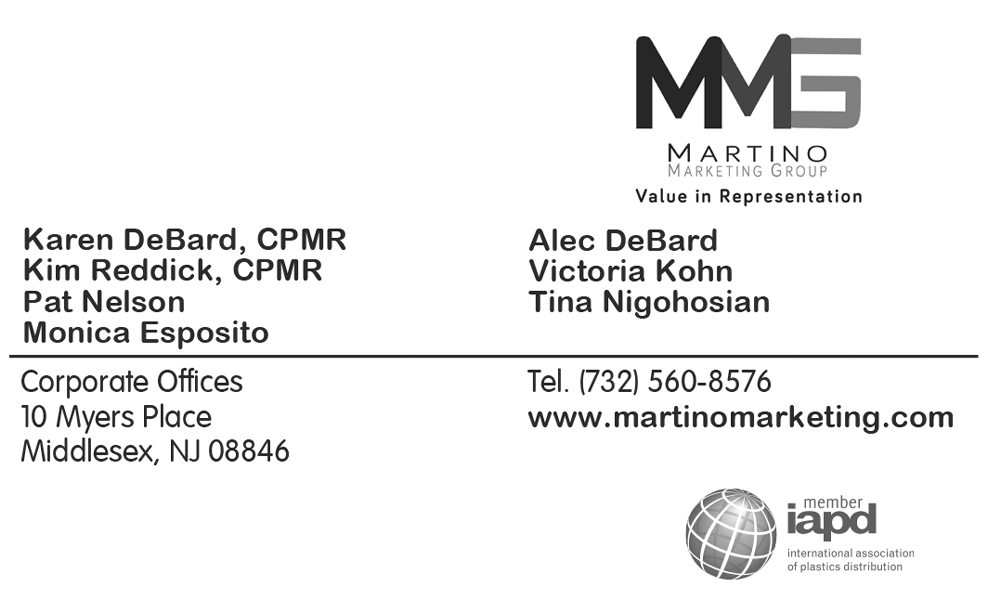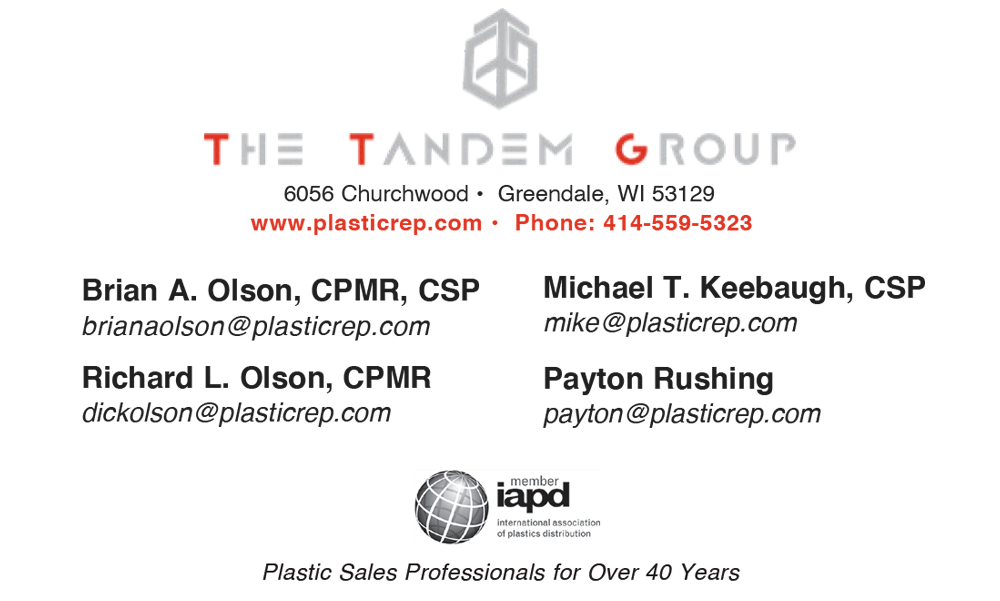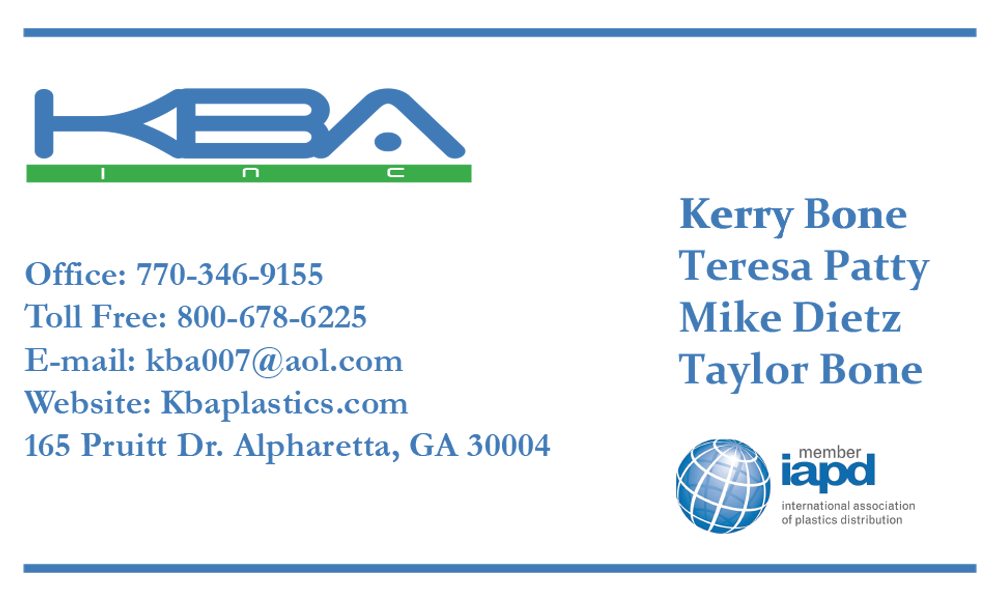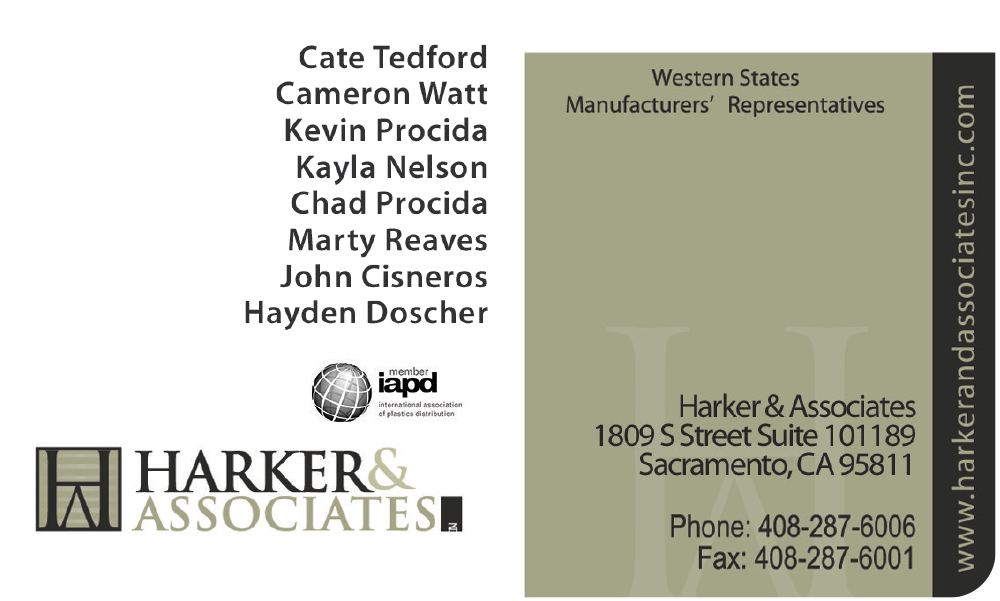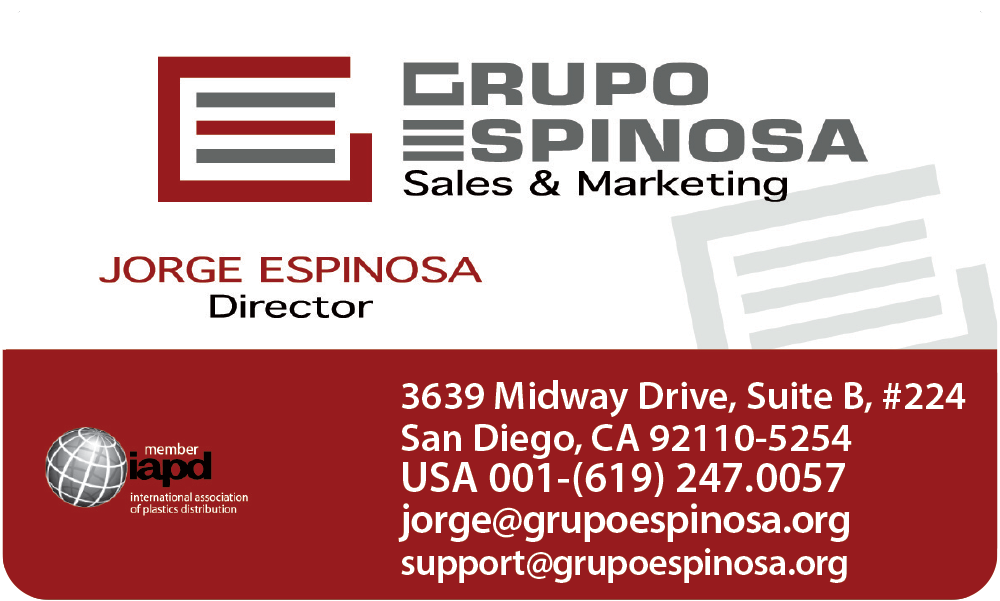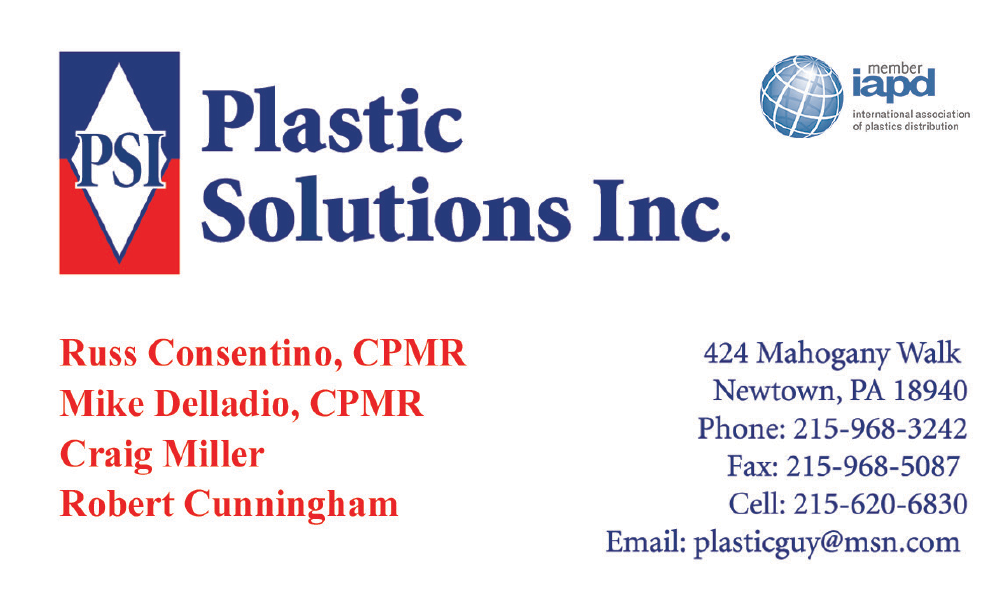of
Performance Plastics: A Publication of The International Association of Plastics Distribution is published bimonthly by the International Association of Plastics Distribution® (IAPD), 6734 W. 121st Street, Overland Park, KS 66209 USA. IAPD members receive this bimonthly magazine as part of their membership dues. Subscription for non-members is $90. Third class postage paid at Shawnee Mission, Kansas, additional mailing offices and foreign mailing in accordance with Publications Agreement No. 40683057. POSTMASTER: Please send address changes to IAPD, 6734 W. 121st Street, Overland Park, KS 66209 USA.
This is the official publication of the International Association of Plastics Distribution and carries news and announcements concerning the IAPD. The association and Performance Plastics: A Publication of The International Association of Plastics Distribution are not responsible for content or opinions other than those relating to association activities.
® Registered, U.S. Patent and Trademark Office, by the International Association of Plastics Distribution. All rights are reserved. Reproduction in any form whatsoever is forbidden without express permission of registered trademark owner.
Performance Plastics: A Publication of The International Association of Plastics Distribution is printed on paper with 10 percent post-consumer recycled content.
IAPD • phone (913) 345-1005 • fax (913) 345-1006 • www.iapd.org
IAPD President
y the time you read this, it will be after the 65th Annual IAPD Convention and Deborah Ragsdale will be IAPD president. I look forward to serving the association as immediate past president. While I will remain involved, this is my last opportunity to address you directly in this magazine. [Editor’s Note: The October/November issue of the magazine will include a transcript of both the outgoing and incoming presidents’ speeches, so you will hear from both Craig and Deborah in the next issue.]
As this issue has a Women in Plastics theme, I wanted to commend all the volunteers who share their expertise on the following pages. Thank you to the authors and all who worked behind the scenes on this issue.
IAPD CEO
ou have probably already realized that this is a very special, very different issue of this publication. For the first time ever, IAPD’s Women in Plastics volunteers have teamed up to provide content for this issue. As you read through these pages, I hope you take a moment to appreciate the depth and breadth of the talent represented by the women in the performance plastics industry. I for one, appreciate their contributions to this publication and their enthusiasm to go beyond their already successful endeavors to try something unprecedented.
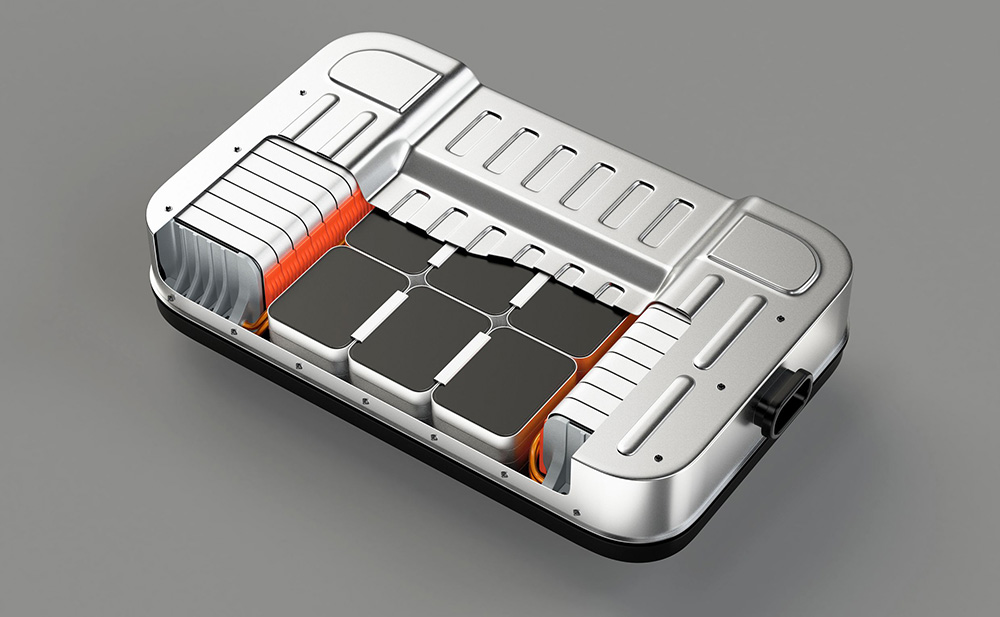
This patent-pending technology allows a climate change impact reduction of almost 20 percent of the Kynar PVDF binder (expressed in kg eq. CO2/kg, according to the ISO 14040 standard) while reducing dependence on upstream crude oil consumption. The crude tall oil used in upstream feedstock production is a residue of the Kraft process of wood pulp manufacturing. The new Kynar CTO grades are certified to be compliant with responsible forestry standards. They do not result in deforestation and there is no direct competition with food crops.

More than a dozen venues have been equipped with new state-of-the-art fan-pleasing upgrades. King StarBoard®, the original marine-grade high density polyethylene (HDPE), was used to create drink rails and tabletops with built-in cooling cup holders so the last sip will be colder and more refreshing than the first. The new drink rail and tabletop installs would be exposed to outdoor conditions including UV rays, heat, rain and humidity. Since these were being installed in high traffic areas, the project required high-impact strength, abrasion resistant and crack resistant materials to better withstand the natural wear and tear from fans.
lastic is one of the most versatile materials of the last century. Found in industries and countries all over the world, plastics have served a crucial role in technological advancements. Plastics are increasingly used as an alternative to metals and wood thanks to their chemical compatibility, machinability and affordability. As plastics continue to go head-to-head in previously metal-dominated markets, it is important to understand one of plastics’ often overlooked characteristics: ease of weldability.
Plastics have a rich and relatively recent industrial history, first becoming a focus in Germany during the 1930s with the invention of plastic welding and eventually becoming more common as additional types of plastics were developed in the 1960s. Many of the industry standards for the bonding and joining of thermoplastics were created in Germany. In 2000, the German Welding Society (DVS) began translating their standards into English. We have since seen an increase in plastic bonding in the United States as well, even making its way into the American Weld Society (AWS) standards committee in 2015.
nvironmental, Social and (Corporate) Governance — or ESG — is a relatively new concept that is being embraced by corporations as they plan their futures. According to Forbes’ Betsy Adkins, “ESG issues were first mentioned in the 2006 United Nation’s Principles for Responsible Investment (PRI) report” with the intent of holding companies responsible for further developing sustainable investments. In practice, it represents a more stakeholder-centric approach to doing business and considers the impact a company can have on its employees, customers and the communities in which it operates.
ccording to the National Safety Council, 540 workers are injured per hour, 12,900 per day, 90,400 per week. This equates to 7 million work-related injuries per year (https://injuryfacts.nsc.org/).
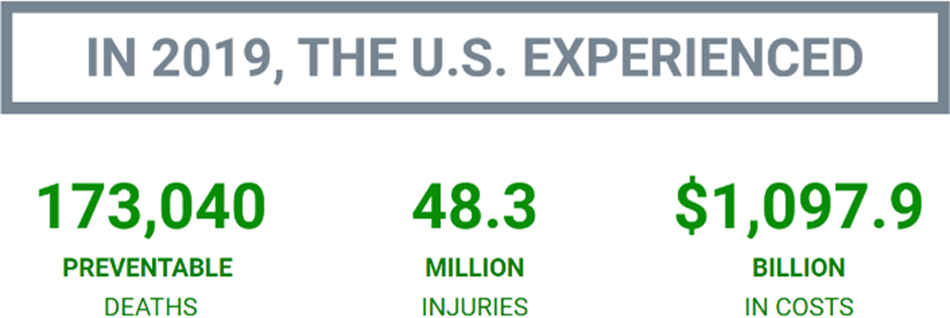

Gears, machine parts, sprockets, star wheels, wear strips and more.
Gears, machine parts, sprockets, star wheels, wear strips and more.
common fallacy is that all plastics are bad for the environment. Another common fallacy is that all plastics are disposable, because the first thing most people think of when they hear “plastics” is what we would consider single-use plastics such as plastic bags, bottle holders, plastic cups and other similar products that often end up in landfills or in our oceans, taking many years before they degrade. But those very properties are also found in the plastics that have been used to protect our environment.
We should not demonize and remove such a versatile material as plastics from any conversation regarding our environment. Plastics have been used for decades to protect our environment. Geosynthetics, a class of plastics used to stabilize the terrain and solve numerous civil engineering problems, are one example. Geosynthetics have been used in landfills as a means for containment, protection, separation and filtering. Without these materials, leachate generated from water seeping into a landfill can get into our groundwater, ruining ecosystems and our drinking water.

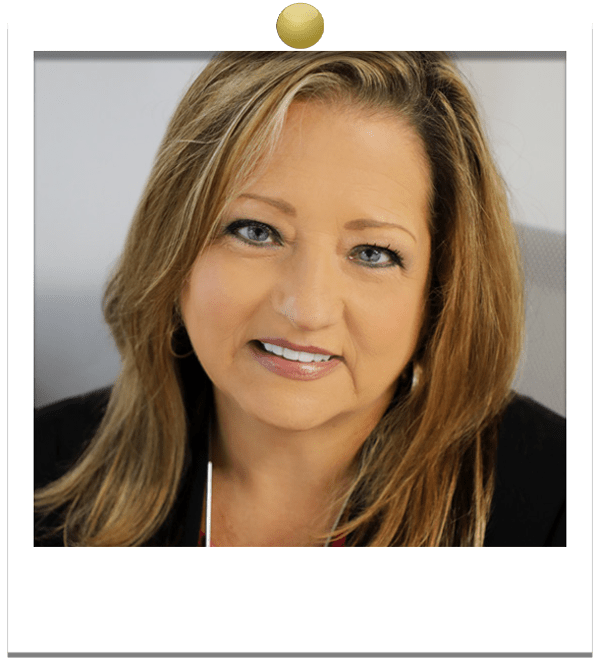

Technology today is moving at the speed of light. But all the tangible parts can be provided by performance plastics. Plastics are never stuck in one market space. We move in tandem with new technology and continually create more products to serve those markets. I see these innovations and adaptations every day. This ability to keep up and continually invent is exciting, no matter what scope of business you are in.
Performance plastics is an arena that is increasingly welcoming to women. The Women in Plastics group is an excellent forum to have your voice heard and discover all the opportunities within this industry. From extrusion operations to the executive level of leadership, the environment is now much more inclusive. It takes many different perspectives to discover and create solutions. We all work in the trenches side by side discovering solutions to the gaps we discover daily with our customers and within our own companies.
uring the October 2020 IAPD Women in Plastics Virtual Event, keynote speaker Rania Anderson said, “80 percent of the decisions about your career are made when you are not in the room … and it takes much more than hard work.” Among all the valuable takeaways from the session, these statements made me pause and reflect on my career — from inside sales rep new to performance plastics in 2007 to associate director of training & development and member of senior management in 2019 to IAPD Pacesetter Award winner in 2020. My story is a testament to what is possible through mentorship, sponsorship, networking and volunteering.
I started in the plastics industry just 11 days after graduating from college. At that time, I didn’t know what I wanted to do, I just knew that I wanted to work and needed a job. I met Eddie Howe, business manager of Curbell Plastics, Inc. in Pittsburgh, PA, USA at a job fair and he hired me shortly after our meeting. Looking back, I couldn’t have known how pivotal a role he would play in my career.
olunteering is more than doing your part for a good cause. It’s a great way to meet new people and strengthen your ties to a community or organization; in addition, it connects people who have common interests, can foster strong relationships and learn new skills that may even be useful on the job.
Philanthropy is one of the core values of Women In Plastics, which manifests itself through volunteerism. While the mission of Women in Plastics is to come together to promote, advance and sustain women in the performance plastics industry, they also form personal connections to one another through philanthropy. The Women in Plastics leadership is committed to developing well rounded women who will not only be industry leaders, but also leaders in their community. Women In Plastics philanthropic events allow participants to work alongside one another and serve others in the communities where they live and visit.
lastics have a PR problem. The ever-growing amount of throwaway plastics is referred to as the plastic waste crisis. The perception of plastics is (zip)tied to beaches littered with plastic bags, empty plastic bottles and other single-use debris from the polystyrene and polypropylene categories. That was certainly my perception of plastic, anyway, as someone who was far removed from any kind of skin in the plastics game.
Recognizing my own ignorance on the plastic problem, I looked for some impartial research to learn more about the topic. I landed on the audiobook Plastic: A Toxic Love Story by Susan Freinkel. If you haven’t heard of it, I highly recommend it.
Coming from a mindset similar to Freinkel (plastics are bad but I’m willing to be open-minded for the sake of reporting), I appreciated her approach. Let’s just say the book was eye-opening. At the risk of sounding hyperbolic, I’d go so far as to call it mind-blowing.
he world of plastics is an expansive one. From thermoplastics to thermosets and everything in between, plastics are everywhere around us. These materials are more than single use — they are enabling technological advancements by providing lighter-weight solutions to replace metals and other heavy materials. Fluoropolymers are one family of plastic materials that have a wide variety of characteristics and applications. Known for their high temperature capabilities, ultra-violet light (UV) resistance, chemical resistance, high purity and good flame and smoke properties, fluoropolymers are often used when service conditions exceed what commodity thermoplastics can handle.
One of these fluoropolymers, polyvinylidene fluorine (PVDF), has many applications. Known for its use in the semiconductor, chemical processing, biotechnology and pharmaceutical industries, PVDF has been used in critical applications for more than 60 years. From piping to tanks to pumps and other process components, PVDF materials are easily fabricated to offer long-standing life in aggressive and challenging environments. However, outside the traditional world of chemical handling, PVDF materials have made their entrance into the colorful world of amusement parks.
othing comes before safety at IAPD member companies, including mine. But a review of our procedures led to an uncomfortable realization: Selling polyolefins by the sheet was a time and labor-intensive process. Picking teams in the warehouse spent hours every day repackaging sheets into smaller order quantities. This involved taking a full skid off the racks with a forklift, un-banding it, manually moving the ordered quantity of sheets to the shipping skid, then re-banding the full skid and replacing it in the racks. Repeated handling of these large, unwieldy sheets — which were 4′ x 8′ or 4′ x 10′ and could weigh more than 200 pounds — could lead to rushing, fatigue and other risky safety behaviors that might result in pinched fingers, back injuries or even something worse.
In response, a cross functional team resolved to create a process to prepackage the most common polyolefin items into set pallet quantities at the extruder, decreasing handling and waste. These efficiencies would allow my company and its customers to reap safety and sustainability rewards.
he COVID-19 pandemic has impacted every facet of our lives, including our home and professional life. Companies continue to reevaluate how we work and from where, and both the economy and our work environments may never be the same. More people are working remotely and more technology solutions are available to help facilitate virtual, rather than in-person, interaction. Consequently, the digital ecosystem and social media universe are experiencing a major boom, so the time to invest in more efficient digital marketing practices couldn’t be better.
Regardless of industry, the last decade ushered in a digital renaissance; seven in 10 U.S. adults use Facebook, a LinkedIn profile is considered essential for nearly any business and your website requires frequent attention and technical tweaks to stand out. For companies slacking on their digital game, the pandemic has greatly accelerated the need to transfer time and resources to online marketing tactics.
s online trainings have risen in popularity, so has online training fatigue. In fact, Zoom fatigue, though not a formal diagnosis, is real. As businesses continue to evolve, virtual training will continue to be a significant portion of our work and training routine. The challenge is: How do you keep your participants engaged while most are feeling the impact of Zoom fatigue? This article describes several simple ways a trainer can overcome Zoom fatigue by creating a more interactive session. Plus, it offers some suggestions for participants to help themselves get the most from their online trainings.
- Excessive amounts of close-up eye contact can be overwhelming, especially to those who are more introverted in style. Introverts experience anxiety for always having to be “on.” In a typical in-person training room, there are always other things to look at. During virtual training, you are expected to look at the camera. People notice if you look elsewhere.
utstanding leadership manifests itself in many forms. Historically many companies have been run by authoritarian leaders who brilliantly led their companies from the top down toward grand success. Although this traditional leadership style has yielded countless successful business ventures, today’s teams seem to respond best to a more contemporary leadership style. The most popular forms of contemporary leadership are the participative, authentic and transformational styles.
A traditional authoritarian leader drives the organization’s decision-making with directive power typically originating with a single dominant leader. This type of leadership is most effective when there is little room for performance errors, during times of uncertainty or when team members are unsure of themselves and benefit from close direction. However, when team members feel fear or resentment in response to this leadership, they will hesitate to give support or share ideas freely.
ave you noticed that in the last several years — and certainly after the pandemic — companies must do more with less? Businesses are constantly challenged to remove cost to win in an increasingly competitive market. Of course, they must do this without negatively impacting the bottom line or customer service. This feat can be achieved by improving processes, upgrading equipment and/or using resources more efficiently. The most critical resource that can make the biggest impact is people. As a leader, it is imperative that you do everything in your power to get the most out of your team.
Danny Wood, Jr.
Brenda Wood
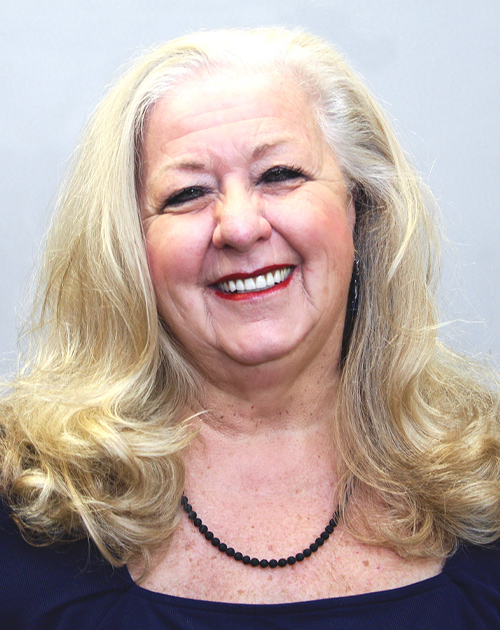
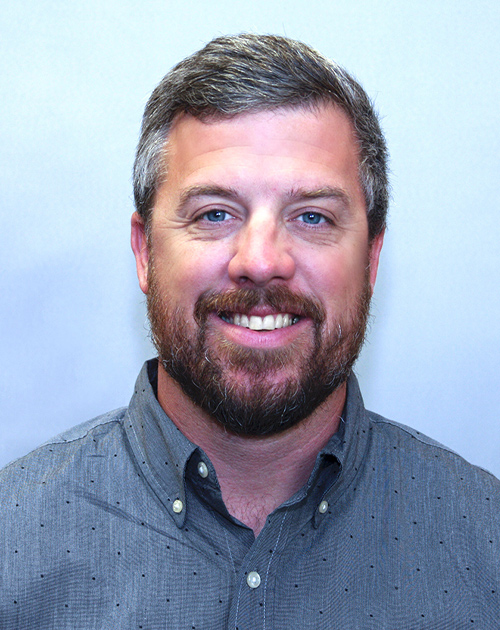
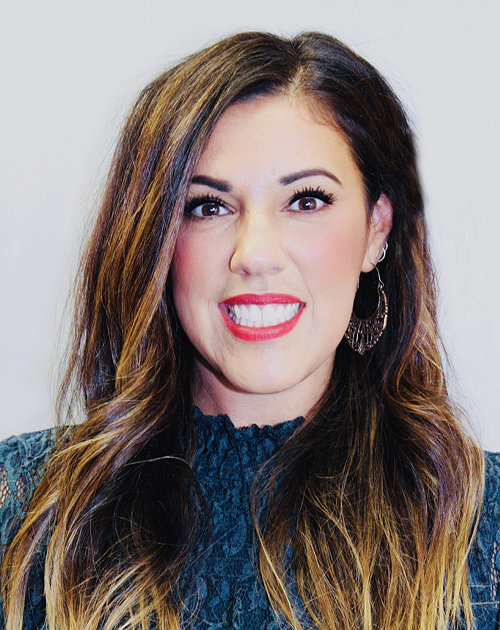

Bui

Chowdhury
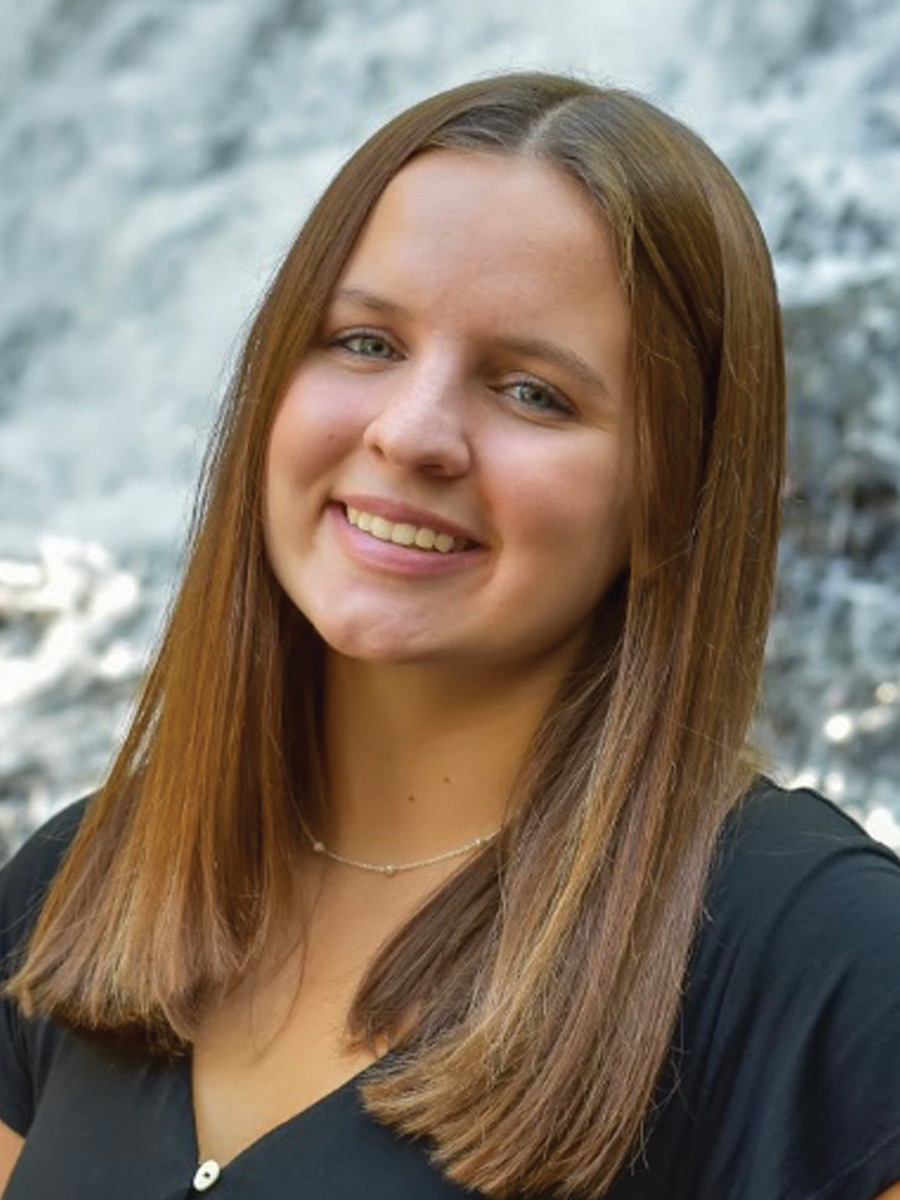
Ficks
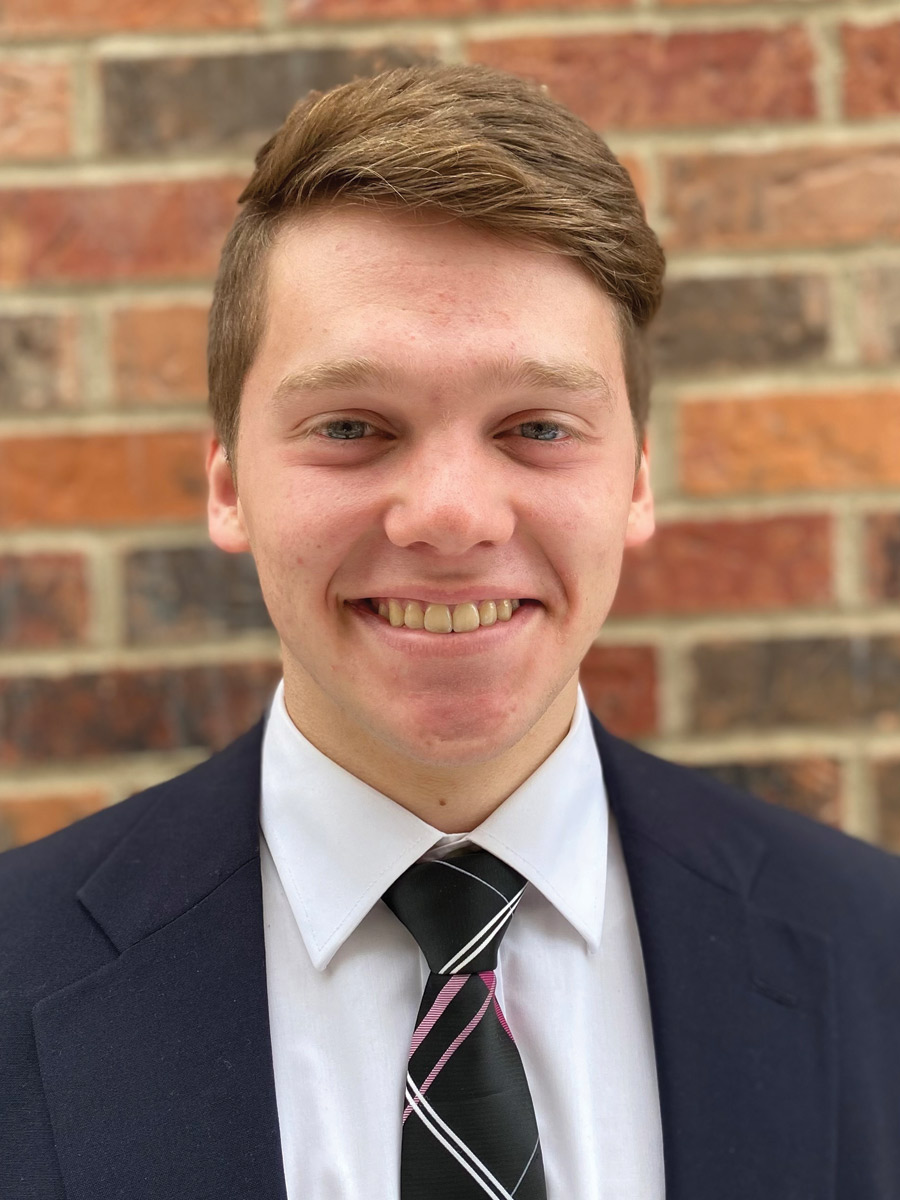
Flake





